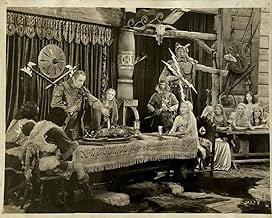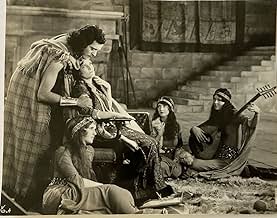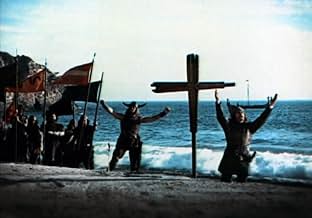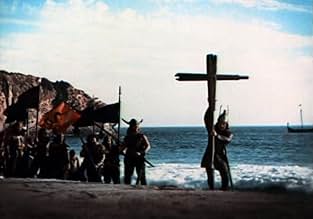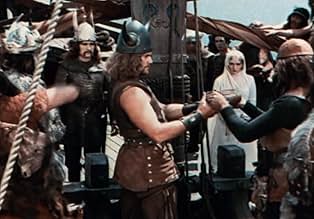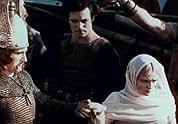Anders Randolf
- Eric the Red
- (as Anders Randolph)
Harry Woods
- Egil
- (as Harry Lewis Woods)
Claire McDowell
- Lady Editha
- (as Claire MacDowell)
Iron Eyes Cody
- Indian
- (sin créditos)
Frank Ellis
- Man Who Gives Sword to Alwin
- (sin créditos)
Eugene McDonald
- Minor Role
- (sin créditos)
Francis McDonald
- Viking Friend of Leif
- (sin créditos)
Lon Poff
- Friar Slain by Vikings
- (sin créditos)
Angelo Rossitto
- Viking Dwarf
- (sin créditos)
Dick Sutherland
- Viking
- (sin créditos)
- Dirección
- Guionistas
- Todo el elenco y el equipo
- Producción, taquilla y más en IMDbPro
Opiniones destacadas
THE VIKING of 1928 still appears to be, in a way, a strikingly absorbing picture. Although it seems that any commitment to viewing this movie may be a privilege of some little group of film scholars, claiming that it leaves no impression whatsoever would surely belittle the significance of silent cinema along with its unique appeal. Obviously, it could not stand a chance against many modern 'pseudo-epic adventures' that heap us with cheap effects which, at moments, cross dangerous borderline placing us at risk of being deprived of imagination. With that in mind, its two strip Technicolor effects would merely appear laughable for some but, paradoxically, renewing for others. Yes, some of its awe-inspiring charm that initially contributed to its adventure merit, still remains.
A misleading assumption lies in a viewpoint that solely two strip Technicolor (for which the movie is most famous) makes THE VIKING worth seeing. Of course, it is impossible to miss this point when even mentioning this movie. Nevertheless, what strikes me most about this film is its storytelling and the fact that it evokes the courage of the Vikings no less than their cruelty. Meanwhile, it does not fall into temptation of reducing them to sheer savages from a purely subjective standpoint of 'baddies.' So to say, such an early achievement becomes authentic and, at the same time, gains realistic targets. It is not only executed in the character of Leif Eriksson (Donald Crisp) who travels towards the new shores but, even, in Erik the Red (Anders Randolf), his father. The sophisticated nature of his character is prompted by contrast within him. On the one hand, his axe is used against his political and religious enemies, even his own son when he discovers his new faith. One the other hand, he draws a very humane conclusion in a memorable scene: 'Leif is my son after all.
THE VIKING with no great stars of the time (being an MGM production), contains all the pictorial elements that we find in cinema of any decade. It substantially depicts love, revenge, fight. We have a Northumbria context of Alwin (LeRoy Mason), taken as a slave, we have a beautiful prototype of female warrior, Helga played by Pauline Starke (of course, a blonde beauty as it is a movie about the Vikings after all), we have kings of two opposing policies, we have this eternal conflict between Christian faith (represented by King Olaf of Norway and his followers, including Erik Leifsson) and pagan cults (represented by Erik the Red, Leif's father, the king of Greenland). Predictably, the Christians are depicted as loving, understanding and forgiving while the pagans are cruel. Yet, there is some nobility in both groups (again with reference to a more psychological approach). Their confrontation, however, is one of the most authentic moments of the theme ever found in silent cinema. Finally, we have the theme of new land, promised land, America (yes, long before Columbus) so much appealing to the audiences of the late 1920s.
But the film is no serious stuff and it should never be treated like one. It is, first and foremost, adventure and entertainment. Just to recall some scenes that have truly stood a test of time and are no less entertaining than they must have been in the late 1920s, including the depiction of Greenland, Vikings' feasts (less savage than in 1958 Fleischer's film), love plot between Alwin and Helga, Egil/Alwin vibrant fight. On the subject of Helga, the beautiful warrior blonde, much credit to Pauline Starke's inspiring performance. The idea of such a female character was not new in this period of silent films. We should remember the lost film QUEEN OF SHEBA and the famous chariot race of the queen and princess Vashti. Nevertheless, Starke's portrayal must have occurred revelatory as early as in 1928 combining appeal and authenticity.
I agree with the opinion of those viewers who praise this film and recommend others to seek it out. Perhaps, it is flawed historically; surely, it is no towering entertainment for viewers used to most dazzling spectacles of our decade. Nonetheless, I believe that anyone may find something for themselves in this early Technicolor treasure and find its reasonable running time fruitful and memorable.
A misleading assumption lies in a viewpoint that solely two strip Technicolor (for which the movie is most famous) makes THE VIKING worth seeing. Of course, it is impossible to miss this point when even mentioning this movie. Nevertheless, what strikes me most about this film is its storytelling and the fact that it evokes the courage of the Vikings no less than their cruelty. Meanwhile, it does not fall into temptation of reducing them to sheer savages from a purely subjective standpoint of 'baddies.' So to say, such an early achievement becomes authentic and, at the same time, gains realistic targets. It is not only executed in the character of Leif Eriksson (Donald Crisp) who travels towards the new shores but, even, in Erik the Red (Anders Randolf), his father. The sophisticated nature of his character is prompted by contrast within him. On the one hand, his axe is used against his political and religious enemies, even his own son when he discovers his new faith. One the other hand, he draws a very humane conclusion in a memorable scene: 'Leif is my son after all.
THE VIKING with no great stars of the time (being an MGM production), contains all the pictorial elements that we find in cinema of any decade. It substantially depicts love, revenge, fight. We have a Northumbria context of Alwin (LeRoy Mason), taken as a slave, we have a beautiful prototype of female warrior, Helga played by Pauline Starke (of course, a blonde beauty as it is a movie about the Vikings after all), we have kings of two opposing policies, we have this eternal conflict between Christian faith (represented by King Olaf of Norway and his followers, including Erik Leifsson) and pagan cults (represented by Erik the Red, Leif's father, the king of Greenland). Predictably, the Christians are depicted as loving, understanding and forgiving while the pagans are cruel. Yet, there is some nobility in both groups (again with reference to a more psychological approach). Their confrontation, however, is one of the most authentic moments of the theme ever found in silent cinema. Finally, we have the theme of new land, promised land, America (yes, long before Columbus) so much appealing to the audiences of the late 1920s.
But the film is no serious stuff and it should never be treated like one. It is, first and foremost, adventure and entertainment. Just to recall some scenes that have truly stood a test of time and are no less entertaining than they must have been in the late 1920s, including the depiction of Greenland, Vikings' feasts (less savage than in 1958 Fleischer's film), love plot between Alwin and Helga, Egil/Alwin vibrant fight. On the subject of Helga, the beautiful warrior blonde, much credit to Pauline Starke's inspiring performance. The idea of such a female character was not new in this period of silent films. We should remember the lost film QUEEN OF SHEBA and the famous chariot race of the queen and princess Vashti. Nevertheless, Starke's portrayal must have occurred revelatory as early as in 1928 combining appeal and authenticity.
I agree with the opinion of those viewers who praise this film and recommend others to seek it out. Perhaps, it is flawed historically; surely, it is no towering entertainment for viewers used to most dazzling spectacles of our decade. Nonetheless, I believe that anyone may find something for themselves in this early Technicolor treasure and find its reasonable running time fruitful and memorable.
Donald Crisp was an extremely prolific actor in sound films. What many people don't know is that he made even more silent films (as actor and director) than sound films. In The Viking, he plays Leif Ericsson, who plans his greatest adventure, to go beyond Greenland and explore for new lands.
A strikingly handsome LeRoy Mason plays Lord Alwin, an English noble. His castle is attacked by the Vikings early in the film, his family scattered, and he is made a slave.
The lovely Pauline Starke plays Helga Nilsson, who is a spunky Nordic gal who is loved by Leif, Alwin, and... well let's not give away too much of the story here.
What makes this film charming and somewhat unique is that it came at the end of the silent era, when camera technique was at its height. It is also filmed in primitive technicolor. The early technicolor process did not render true color as we know it today. The muted shades of the film actually help to make the historic subject matter of the film more remote, as though one were actually watching something that happened long, long ago.
The version of this film that I saw had sound effects, and a symphonic musical score that mixed new music with lots of Richard Wagner at climactic moments. It all worked very well.
It's amazing to me that this very entertaining film is almost unknown today.
A strikingly handsome LeRoy Mason plays Lord Alwin, an English noble. His castle is attacked by the Vikings early in the film, his family scattered, and he is made a slave.
The lovely Pauline Starke plays Helga Nilsson, who is a spunky Nordic gal who is loved by Leif, Alwin, and... well let's not give away too much of the story here.
What makes this film charming and somewhat unique is that it came at the end of the silent era, when camera technique was at its height. It is also filmed in primitive technicolor. The early technicolor process did not render true color as we know it today. The muted shades of the film actually help to make the historic subject matter of the film more remote, as though one were actually watching something that happened long, long ago.
The version of this film that I saw had sound effects, and a symphonic musical score that mixed new music with lots of Richard Wagner at climactic moments. It all worked very well.
It's amazing to me that this very entertaining film is almost unknown today.
A handsomely staged silent epic created to showcase the new 2-strip Technicolor process. All the male leads fall for Viking maiden Helga (Pauline Starke, looking exceedingly fetching in her Viking outfits), but there's little doubt about which of them will claim her heart. Worth catching for the sight of a young Donald Crisp looking like a drummer in some early 1970s prog rock band.
There are so many two-strip Technicolor features lost (Laurel and Hardy's The Rogue Song (1930) comes to mind) or just partially intact, that it was a pleasure to see one that seems not only intact (with no black and white inserts) but also as beautiful as originally released. This film is not colorized, as is often done with early black and white films; it was filmed in color, but without the yellow component that was added in the mid 30's that most of us know as Technicolor. As a result, the reds, blues and browns look pretty good, but you will notice the yellows and greens look a bit off color. Still, it is a great example of the process and worth seeing for that reason alone. But there are also some good action sequences that are sure to please lovers of that genre. I also enjoyed the backdrop of the plot; that of Leif Ericsson sailing west to discover America in the 12th century.
THE VIKING is a film I happened to come upon on TCM the other night, immediately recognizing DONALD CRISP as Leif Ericsson. I was very impressed with the female lead, PAULINE STARKE as Helga, whose lovely face, high cheekbones and steady gaze withstood all those color closeups in fine style. She also happened to be well cast at the headstrong heroine who takes a wealthy nobleman for her slave.
But what really amazed me is the quality of the Technicolor photography, at least ten years before Hollywood was making use of color photography in some of its major films.
The TCM print featured some incidental sound effects and background music. At times, I forgot I was watching a silent film and the use of title cards was minimal.
Well worth watching as a curiosity, but not for historical accuracy.
But what really amazed me is the quality of the Technicolor photography, at least ten years before Hollywood was making use of color photography in some of its major films.
The TCM print featured some incidental sound effects and background music. At times, I forgot I was watching a silent film and the use of title cards was minimal.
Well worth watching as a curiosity, but not for historical accuracy.
¿Sabías que…?
- TriviaWhen the film opened at the Embassy Theatre in New York City on November 28, 1928, it was still silent and was accompanied by a live orchestral accompaniment. In December 1928 a musical score was recorded, sound-on-disc, and this version was distributed by Metro-Goldwyn-Mayer (MGM) in 1929.
- ErroresViking women neither shaved their underarms nor wore the strapless bustiers.
- Citas
Title Card: A thousand years ago, long before any white man set foot on the American shore, Viking sea rovers sailed out of the north and down the waterways of the world. These were men of might, who laughed in the teeth of the tempest, and leaped into battle with a song. Plundering - ravaging - they raided the coast of Europe - until the whole world trembled at the very name - THE VIKING.
- Créditos curiososThe title card bills the three stars in the order Pauline Starke [top billing], Donald Crisp [second billing], and Le Roy Mason [third billing]. But the opening credits end with "The Players" listed in the order: first "Leif Erickson ... Donald Crisp," second "Helga . . . Pauline Starke, third "Alwin . . . Le Roy Mason," etc. The characters appear on screen in the order Alwin, Helga, and Leif Erickson.
- ConexionesFeatured in New England Legends: Creepy Christmas (2019)
Selecciones populares
Inicia sesión para calificar y agrega a la lista de videos para obtener recomendaciones personalizadas
- How long is The Viking?Con tecnología de Alexa
Detalles
Taquilla
- Presupuesto
- USD 325,000 (estimado)
- Tiempo de ejecución1 hora 30 minutos
Contribuir a esta página
Sugiere una edición o agrega el contenido que falta


